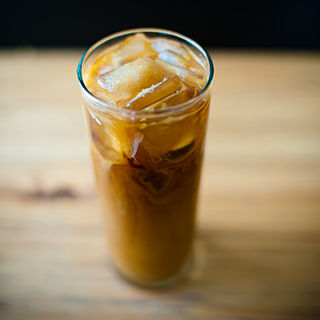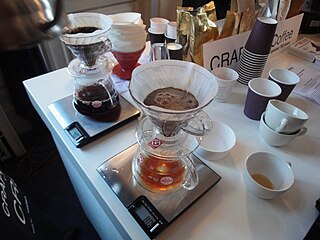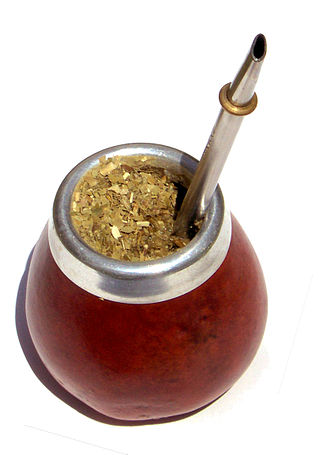Pisco is a colorless or yellowish-to-amber colored spirit produced in winemaking regions of Peru and Chile. Made by distilling fermented grape juice into a high-proof spirit, it was developed by 16th-century Spanish settlers as an alternative to orujo, a pomace brandy that was being imported from Spain. It had the advantages of being produced from abundant domestically grown fruit and reducing the volume of alcoholic beverages transported to remote locations.

Caffè latte, often shortened to just latte in English, is a coffee drink of Italian origin made with espresso and steamed milk. Variants include the chocolate-flavored mocha or replacing the coffee with another beverage base such as masala chai, mate, matcha, turmeric or rooibos; alternatives to milk, such as soy milk or almond milk, are also used.

A caffeinated drink, or caffeinated beverage, is a drink that contains caffeine, a stimulant that is legal practically all over the world. Some are naturally caffeinated while others have caffeine added as an ingredient.

New World wines are those wines produced outside the traditional winegrowing areas of Europe and the Middle East, in particular from Argentina, Australia, Canada, Chile, Mexico, New Zealand, South Africa and the United States. The phrase connotes a distinction between these "New World" wines and those wines produced in "Old World" countries with a long-established history of wine production, essentially in Europe, most notably: France, Italy, Germany, Spain and Portugal.

A pisco sour is an alcoholic cocktail of Peruvian origin that is traditional to Peruvian cuisine and Chilean cuisine. The drink's name comes from pisco, which is its base liquor, and the cocktail term sour, about sour citrus juice and sweetener components. The Peruvian pisco sour uses Peruvian pisco as the base liquor and adds freshly squeezed lime juice, simple syrup, ice, egg white, and Angostura bitters. The Chilean version is similar, but uses Chilean pisco and Pica lime, and excludes the bitters and egg white. Other variants of the cocktail include those created with fruits like pineapple or plants such as coca leaves.

A sour is a traditional family of mixed drinks. Sours belong to one of the old families of original cocktails and are described by Jerry Thomas in his 1862 book How to Mix Drinks.

Advocaat or advocatenborrel is a traditional Dutch alcoholic beverage made from eggs, sugar, and brandy. The rich and creamy drink has a smooth, custard-like consistency. The typical alcohol content is generally between 14% and 20% ABV. Its contents may be a blend of egg yolks, aromatic spirits, sugar or honey, brandy, vanilla, and sometimes cream. Notable makers of advocaat include Warninks, Bols, Darna Ovo Liker, DeKuyper, and Verpoorten.

Iced coffee is a coffee beverage served cold, It may be prepared either by brewing coffee normally and then serving it over ice or in cold milk or by brewing the coffee cold. In hot brewing, sweeteners and flavoring may be added before cooling, as they dissolve faster. Iced coffee can also be sweetened with pre-dissolved sugar in water.

Tea culture is defined by how tea is made and consumed, how people interact with tea, and the aesthetics surrounding tea drinking.
Peruvian cuisine reflects local practices and ingredients including influences mainly from the indigenous population, including the Inca, and cuisines brought by immigrants from Europe, Asia, and Africa. Without the familiar ingredients from their home countries, immigrants modified their traditional cuisines by using ingredients available in Peru.

Piscola or Combinado Nacional is a highball cocktail, made of pisco and most commonly a cola drink, that is popular in Chile. A piscola may be black or white depending if it is mixed with a cola or ginger ale, tonic, Sprite or a similar soft drink. The drink is prepared by filling a highball glass with ice and then adding pisco followed by the soft drink in a proportion ranging from 1:1 to 1:3. Sometimes slices of lemon or key lime may be added. In Chile, February 8 has been celebrated as the "day of the piscola" since 2003.

Coffee preparation is the process of turning coffee beans into liquid coffee. While the particular steps vary with the type of coffee and with the raw materials, the process includes four basic steps: raw coffee beans must be roasted, the roasted coffee beans must then be ground, and the ground coffee must then be mixed with hot or cold water for a specific time (brewed), the liquid coffee extraction must be separated from the used grounds, and finally, if desired, the extracted coffee is combined with other elements of the desired beverage, such as sweeteners, dairy products, dairy alternatives, or toppings.

Mate or maté is a traditional South American caffeine-rich infused herbal drink. It is also known as chimarrão or cimarrón. It is made by soaking dried leaves of the yerba mate in hot water and is traditionally served with a metal straw (bombilla) in a container typically made from a calabash gourd, but also in some areas made from a cattle horn (guampa). A very similar preparation, mate cocido, removes some of the plant material and sometimes comes in tea bags. Today, mate is sold commercially as "yerba mate" in tea bags and as bottled iced tea.

Caffè Americano is a type of coffee drink prepared by diluting an espresso with hot water, giving it a different flavor from traditionally brewed coffee. Its strength varies with the number of shots of espresso and amount of water added. The name is also spelled with varying capitalization and use of diacritics: e.g., café americano.
A carajillo is a hot coffee drink to which a hard liquor is added. Similar to Irish coffee, it is typical of Spain and several Latin American countries, such as Colombia and Venezuela, where it is usually made with brandy; Cuba, where it is usually made with rum; and in Mexico where mezcal or a coffee liqueur such as Kahlúa or Tía María may be used. Spices such as cinnamon and fruit such as lemon peel are commonly added to more elaborate versions in Spain. Carajillo is usually served in a small glass.

Chilean cuisine stems mainly from the combination of traditional Spanish cuisine, Chilean Mapuche culture and local ingredients, with later important influences from other European cuisines, particularly from Germany, the United Kingdom and France. The food tradition and recipes in Chile are notable for the variety of flavours and ingredients, with the country's diverse geography and climate hosting a wide range of agricultural produce, fruits and vegetables. The long coastline and the peoples' relationship with the Pacific Ocean add an immense array of seafood to Chilean cuisine, with the country's waters home to unique species of fish, molluscs, crustaceans and algae, thanks to the oxygen-rich water carried in by the Humboldt Current. Chile is also one of the world's largest producers of wine and many Chilean recipes are enhanced and accompanied by local wines. The confection dulce de leche was invented in Chile and is one of the country's most notable contributions to world cuisine.

Salep, also spelled sahlep or sahlab, is a flour made from the tubers of the orchid genus Orchis. These tubers contain a nutritious, starchy polysaccharide called glucomannan. Salep flour is consumed in beverages and desserts, especially in the cuisines of the former Ottoman Empire, notably in the Levant where it is a traditional winter beverage. An increase in consumption is causing local extinctions of orchids in parts of Turkey and Iran.













